Windows
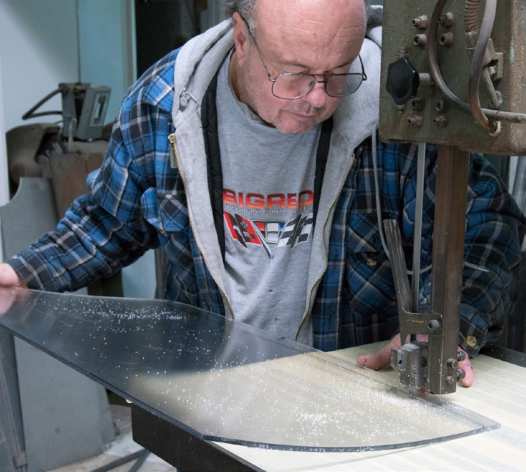
Just because Big Red is a race car and has a Lexan™ back window and quarter windows doesn’t mean it has to detract from the factory look. Keeping with the theme of retaining as much of the natural appearance as possible, the original window trim is used, and it covers some of evidence that the windows are not glass.
The front windshield is allowed to be glass, so they can keep that part stock. The windshield (and back window) were installed from the factory with a rope-like tar strip (similar to butyl) between the glass and the body. Laws have changed since the 1960s, and glass installers aren’t allowed anymore to use butyl to attach windshields and back glass. They are required to use polyurethane adhesive to essentially glue them into the body. The windshield is Big Red’s only piece of glass, and it’s the only window to be installed with sealant. Tony from All Auto Glass, Inc., cut a V-shape in the nozzle of his polyurethane tube and he laid down a tall bead all the way around the edge of the glass. He’s a real pro, and made the job look easy.
Once the glass was in place, the factory trim was installed with some new clips from Steve’s Camaros. The 0.090-inch aluminum window safety tabs are designed to hold the stainless-steel trim and windows in place at high speeds. In 2013, Tim
made the windshield tabs to mimic the original rear window tabs in order to comply with the SCTA rules required to run at El Mirage and Bonneville. The tabs were polished before reinstallation. In March 2010, Big Red ran the Mojave Mile for the first time. RJ ran 200.7 mph without door windows. That was great, but the team knew Big Red could do better. They built new Lexan™ door windows and installed narrower front wheels to try to run a bigger number for the September 2010 Mojave Mile. The addition of the door windows definitely helped improve aerodynamics, because RJ’s best run of the day was 210.4 mph. Since then, Big Red runs all Land Speed/Top Speed events with the Lexan™ door windows.
Non-glass windows do scratch easily, and the old windows weren’t looking great. Everything is new and shiny, so it was time for some new door windows. Tim pulled the old windows off their frames so he could use them as templates to make new ones. Tim taped up the bandsaw table to protect the Lexan™ while he cut along the lines. With the windows cut and the frame holes drilled, he made one more check before cutting the holes for the top latch that hooks to the top of the cage. Since the windows are only attached to the top edge of the door, they required
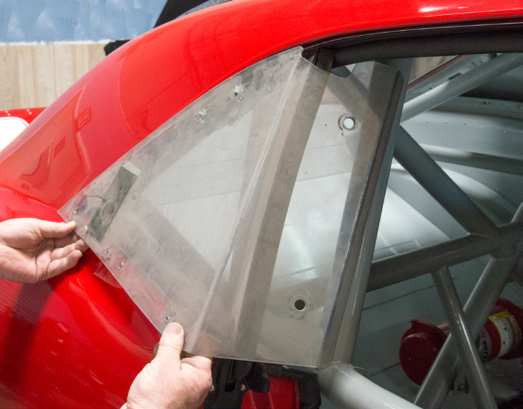
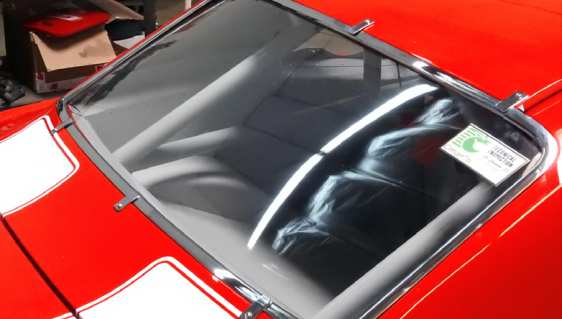
support rods that attached to the interior door panels to keep them rigid. When the top latch is installed, it pulls the Lexan™ tight against the window seals and keep air moving around the car at over 150 mph, which stops it from sucking the leading edge of windows away from the body. Tim left the protective film on the outside of the window to protect it until they are ready to run the next Land Speed/Top Speed event.
The mechanisms for rolling down the quarter windows have been gone since 1987, so the rear quarter windows had to be fixed (stationary). The old Lexan™ quarter windows and their mounting tabs were ditched for new pieces. The old design of two short tabs was replaced by a single long bracket that runs the length of the quarter window to trim out the quarter panel. New panels were cut, and Tim used
3M ™ Black Super Weatherstrip and Gasket Adhesive to affix the factory trim. The quarter windows wouldn’t retain the factory look without the proper chrome trim and seal. The team does have a different set of complete doors with real roll-up glass, so the trim has to be in the correct position to work with the glass windows. Any time the rear quarter windows need to be removed, they come out with the release of three Dzus fasteners.
Tim holds up an old window used in previous events, such as the first Mojave
Mile (2010) and Spectre’s 341 Challenge (2011). The last time they were used
was the 2012 Big Bore Bash. Their application was usually for events not requiring door windows. The flap protruding into the car is to help deflect some air from getting into the car at speed. If the crew decides to run this design in the future, they’ll build a new set. Pikes Peak would have been a good race to use them, but they chose to run the standard configuration quarter windows. Tim set the rear window in place for fitment. It isn’t installed with polyurethane like the windshield. The rear
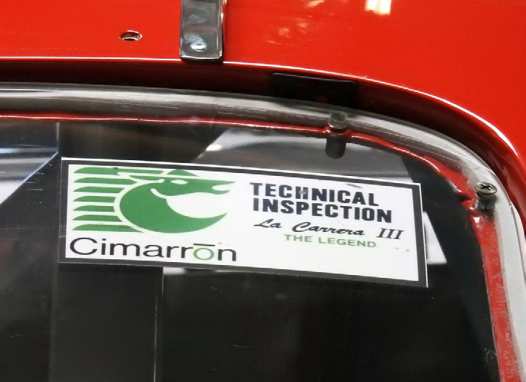
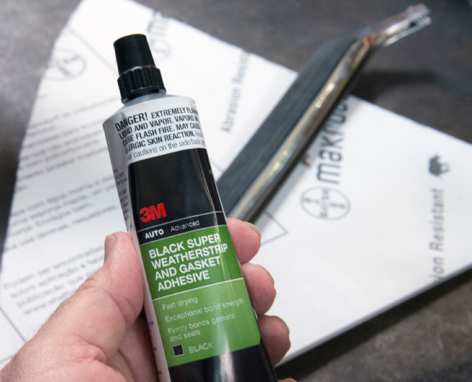
window is more serviceable. First a half-inch foam weatherstrip was installed around the perimeter of the window. The foam keeps the Lexan™ pushed out against the window trim. Countersunk stainless-steel screws thread into Nutserts installed in the window channel. Being fastened to the body helps reduce the chance that it will blow out or be sucked out at high speeds. With the window trim installed, the screws and foam weatherstrip are hidden.
The rear window trim retaining clips were made by Bill Osborne when Big Red was originally built. The tabs keep the back window and window trim from popping out due to increased pressure inside the car when running with the windows down. The road course and racing events like Pikes Peak International Hill Climb are run without door glass. Big Red uses Lexan™ door windows at most Land Speed/Top Speed events for improved aerodynamics.